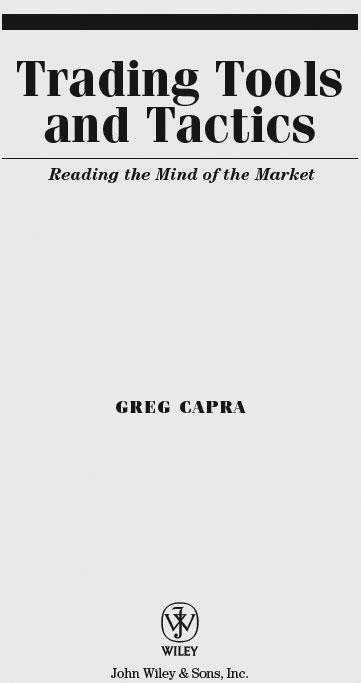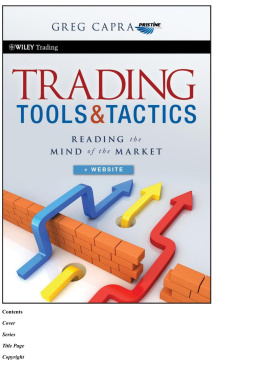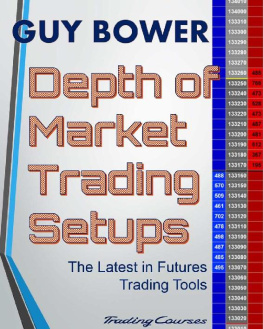
Contents
Cover
Series
Title Page
Copyright
Dedication
Contents
Cover
Series
Title Page
Copyright
Introduction: The Journey Begins
UNDERSTANDING THE LANGUAGE OF CHARTS AND PRICE ACTION
HOW TO USE THIS BOOK
ABOUT THE CHARTS IN THIS BOOK
A NOTE ABOUT PRISTINE.COM
Chapter 1: Subjective Doesn't Work in the Market
THE GURU SYNDROME
THE PITFALLS OF FUNDAMENTAL ANALYSIS
TECHNICAL INDICATORS: ADDING SUBJECTIVITY TO THE CHART
APPROACHING THE MARKETS OBJECTIVELY
IN SUMMARY
Chapter 2: Candlestick Analysis
A SINGLE CANDLE
MULTIPLE CANDLE FORMATIONS
FAILURE IS NOT ALWAYS BAD
IN SUMMARY
Chapter 3: Support and Resistance
PRICE PATTERNS
RECOGNIZING REFERENCE POINTS
THE TWO FORMS OF SUPPORT AND RESISTANCE: MAJOR AND MINOR
HOW SUPPORT AND RESISTANCE AREAS FORM
IN SUMMARY
Chapter 4: Moving Averages the Right Way
A VALUABLE TECHNICAL MEASUREMENT
CONVERGENCE CAN HELP
MOVING AVERAGES AS FOCAL AREAS
STAYING OBJECTIVE
A FEW GOOD RULES WHILE USING MOVING AVERAGES
OTHER POINTS TO CONSIDER
MOVING AVERAGES TO FIND PLAYS
IN SUMMARY
Chapter 5: Volume Is Money
THE FALLACIES OF VOLUME
USING VOLUME PROPERLY
THE PRIMARY USES OF VOLUME
VOLUME AS IT RELATES TO TRADABILITY
IN SUMMARY
Chapter 6: Retracement Analysis
THE CONCEPT OF RETRACEMENTS
TO RETRACE OR NOT TO RETRACE?
RETRACEMENTS IMPLY A TREND
CONTINUING TO KEEP IT OBJECTIVE
WHAT LIES BEYOND 60 PERCENT?
RETRACEMENT LEVELS IN DOWNTRENDS
A SPECIAL RETRACEMENT PATTERN
RETRACEMENT LEVELS IN SIDEWAYS TRENDS
WHAT LIES BEYOND 100 PERCENT?
THE BIGGER PICTURE
IN SUMMARY
Chapter 7: Bar-by-Bar Analysis
OBJECTIVITY IS STILL THE GOAL
A QUICK REVIEW OF INDIVIDUAL BARS
HOW THE BARS INTERACT
ADDITIONAL THOUGHTS
IN SUMMARY
Chapter 8: Market Internals
DETERMINING PRICE MOVEMENT
WHEN TO BE DIFFERENT
FAVORITE MARKET INTERNALS
A QUICK OVERVIEW OF INTERMARKET ANALYSIS
IN SUMMARY
Chapter 9: Relative Strength
IDENTIFYING DIFFERENT TYPES OF RELATIVE STRENGTH
IS RELATIVE STRENGTH ALWAYS GOOD?
RELATIVE STRENGTH AND WEAKNESS WITH MORNING GAPS
RELATIVE STRENGTH WITH SECTOR ANALYSIS
RELATIVE STRENGTH TO MARKET INTERNALS
IN SUMMARY
Chapter 10: The Trend Is Your Friend
WHAT MAKES A TREND?
PIVOTS
WHEN PIVOTS COME TOGETHER
SOME SUBJECTIVE GUIDANCE
KEEPING IT CLEAN
CHECKING THE REACTION
FINAL THOUGHTS
IN SUMMARY
Chapter 11: Shoot the Gap
WHAT CAUSES A GAP?
FALLACIES ABOUT GAPS
GAPS AND THE DAILY CHART
THE INTRADAY PLAY
IN SUMMARY
Chapter 12: Frame-by-Frame
WHICH TIME FRAMES?
THE FIRST GOAL OF USING MULTIPLE TIME FRAMES
A POWERFUL CONCEPT EMERGES
WARNING SIGNS IN THE MICRO TREND
HIDDEN PATTERNS
IN SUMMARY
Chapter 13: Making Failure Work for You
DID THE PLAY STOP, OR DID THE PATTERN FAIL?
WHEN GOOD PATTERNS FAIL
CAPITALIZING ON PREDICTABLE FAILURES
EXPECTED (OR UNEXPECTED) FAILURE
IN SUMMARY
Chapter 14: Manage the Trade and the Money
MANAGING THE MONEYSHARE SIZE
HOW MUCH TO RISK
MANAGING THE MONEYTHROUGHOUT THE DAY
CONSIDERATIONS WHEN SWING TRADING
BASIC TRADE MANAGEMENT CONCEPTS
MANAGING THE TRADESTAYING WITH THE TREND
MANAGING THE TRADEZOOMING DOWN
IN SUMMARY
Chapter 15: Getting Through a Typical Trading Day
BEGINNING YOUR DAY
PLANNING YOUR TRADE, TRADING YOUR PLAN
AFTER THE CLOSE
MAXIMIZING THE WINNERS, AND HANDLING THE LOSERS PROPERLY
Chapter 16: There Is Only One Truth in the Markets
PRICE IS KING
Appendix A: Abbreviations
Appendix B: Trade Types
Glossary
COMMONLY USED MARKET TERMS
GLOSSARY OF COMMONLY USED TECHNICAL TERMS
About the Companion Website
Index
Founded in 1807, John Wiley & Sons is the oldest independent publishing company in the United States. With offices in North America, Europe, Australia and Asia, Wiley is globally committed to developing and marketing print and electronic products and services for our customers
professional and personal knowledge and understanding.
The Wiley Trading series features books by traders who have survived the markets ever changing temperament and have prosperedsome by reinventing systems, others by getting back to basics. Whether a novice trader, professional or somewhere in-between, these books will provide the advice and strategies needed to prosper today and well into the future.
For a list of available titles, please visit our Web site at www.WileyFinance.com.

Copyright 2011 by Greg Capra. All rights reserved.
Published by John Wiley & Sons, Inc., Hoboken, New Jersey.
Published simultaneously in Canada.
No part of this publication may be reproduced, stored in a retrieval system, or transmitted in any form or by any means, electronic, mechanical, photocopying, recording, scanning, or otherwise, except as permitted under Section 107 or 108 of the 1976 United States Copyright Act, without either the prior written permission of the Publisher, or authorization through payment of the appropriate per-copy fee to the Copyright Clearance Center, Inc., 222 Rosewood Drive, Danvers, MA 01923, (978) 750-8400, fax (978) 646-8600, or on the Web at www.copyright.com. Requests to the Publisher for permission should be addressed to the Permissions Department, John Wiley & Sons, Inc., 111 River Street, Hoboken, NJ 07030, (201) 748-6011, fax (201) 748-6008, or online at http://www.wiley.com/go/permissions.
Limit of Liability/Disclaimer of Warranty: While the publisher and author have used their best efforts in preparing this book, they make no representations or warranties with respect to the accuracy or completeness of the contents of this book and specifically disclaim any implied warranties of merchantability or fitness for a particular purpose. No warranty may be created or extended by sales representatives or written sales materials. The advice and strategies contained herein may not be suitable for your situation. You should consult with a professional where appropriate. Neither the publisher nor author shall be liable for any loss of profit or any other commercial damages, including but not limited to special, incidental, consequential, or other damages.
Next page







![Harry Boxer [Harry Boxer] - Profitable Day and Swing Trading: Using Price / Volume Surges and Pattern Recognition to Catch Big Moves in the Stock Market, + Website](/uploads/posts/book/124137/thumbs/harry-boxer-harry-boxer-profitable-day-and.jpg)


